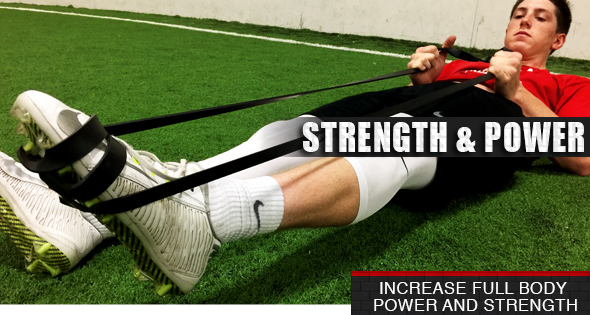Sports Therapy | Sport Injuries | Ankle Injuries Strength And Stability Routine
Athletes who are proactive with sports therapy and corrective exercises can avoid sports injuries and set backs. Athletes who regularly perform flexibility exercises, myofascial release techniques, and active warm ups will see a boost in athletic production while lowering the chance of sustaining shoulder or ankle injuries.
%%Panel.bannersocial%%
The intensity and movements required to compete in a certain sport or to complete a workout will determine what stretching and warm up exercises need to be completed to help avoid sports injuries. Athletes who are performing high intensity activities (HIIT Training, Soccer Game, Endurance Events) will want to take extra time to perform flexibility exercises, perform an active warm up of some kind (preferably one which mimics the movements used during raining or competition) and using the Recovery Foam Roller on any extra sore parts of the body.
Athletes should go to the Recovery Section and explore how the Recovery Foam Roller can be used to relieve soreness and tightness in different parts of the body. The Ballistic Bands are also a great tool to use to avoid sports injuries. Athletes can find flexibility exercises in the Recovery Section which will allow athletes to actively increase the range of motion of the thighs and hips.
Sports Therapy For Sports Injuries
It is important athletes use corrective, functional, and flexibility exercises during their training sessions. Performing sports therapy drills like the Ankle Injuries Strength And Stability Routine, Prevent And Rehab A Rotator Cuff Injury, and the Y-W-T Drill will help athletes to avoid shoulder, knee, and ankle injuries.
Performing these activities can be a challenge for some athletes, especially young athletes who recover relatively quickly. If athlete can develop good habits at a young age and perform sports therapy exercises to maintain flexibility, mobility, and strength in smaller stabilizing muscles they will experience fewer injuries throughout their athletic career and into their post athletic career. Athletes can avoid shoulder pain or operation by maintaining proper strength and flexibility in key areas. Athletes can avoid knee and hip pain by properly stretching and rolling certain muscles in the thigh. The sooner athletes learn how to perform these important sport therapy exercises the less chance they will experience a set back due to injuries.
Sports Therapy For Ankle Injuries
Ankle injuries often occur when the stabilizing muscles in the leg become weak or inflexible and are forced to move out of their range of motion. This causes inflammation and possible damage to the ligaments surrounding the ankle. Proactive steps which can be taken to avoid ankle injuries include using the Recovery Foam Roller to foam roll the muscles in the calves ( as tightness in the calves can cause movements to be altered by causing shin splints or pain in the foot) and actively strengthening the muscles in that control the movement of the ankle.
To perform the Ankle Injuries Strength And Stability Routine athletes will need a Ballistic Band. Athletes will wrap the Ballistic Band around the ball of their foot to allow maximum tension to be applied during the sports therapy exercise. Athletes can loop the Ballistic Band once around the foot, or can more secure the Ballistic Band by grasping the Ballistic Band a few inches apart, creating a loop, and placing the loop around the ball of the foot. This will allow greater tension and control during the Ankle Injuries Strength And Stability Routine. Athletes will lie on the ground with both legs straight during the entire Ankle Injuries Strength And Stability Routine.
The Ankle Injuries Strength And Stability Routine is made up of four separate sports therapy exercises. The first exercise in the Ankle Injuries Strength And Stability Routine requires the athlete to raise the heel slightly off the ground, move to laying on their back, and move the toes up and down. This up and down action will be continued for 10-15 repetitions, or 30 seconds. Once the sports therapy exercise is complete athletes will switch the Ballistic Band to the opposite foot and perform the same action for the same amount of time or repetitions. Athletes will perform 2-3 rounds of the first ankle injuries rehab exercise before moving to the second portion of the Ankle Injuries Strength And Stability Routine.
The second portion of the ankle injuries rehab routine requires the athlete to move their toe side to side. Just as in the first portion of the Ankle Injuries Strength And Stability Routine athletes will alternate performing 2-3 rounds of 10-12, or 30 second, rounds of the sports therapy exercise. Athletes will then perform the same amount of sets and repetitions moving the toe in a circle on both the right and left foot.
The final portion of the Ankle Injuries Strength And Stability Routine will only be performed one time on each foot. Athletes will move into the lying position with their foot slightly elevated off the ground and attempt to write the alphabet in the air with their toe.
Avoid Sport Injuries
While athletes are performing the Ankle Injuries Strength And Stability Routine, or any other proactive sports therapy, they need to pay attention to form and targeting the appropriate muscles in the body. When athletes working through the Ankle Injuries Strength And Stability Routine at the beginning of their training it is important they focus on not allowing the leg to bend or flex at the knee or hip. This may be more difficult the first time the ankle injuries prevention training is performed, however, the more consistent athletes are with performing the sports therapy exercises the more comfortable and familiar they will become with the movements.
Athletes and coaches will also want to take their time working through all four sections of the Ankle Injuries Strength And Stability Routine. The goal of the sport therapy exercises is not to actively increase the speed of the targeted muscles, but to instead increase strength and stability to avoid ankle injuries.

